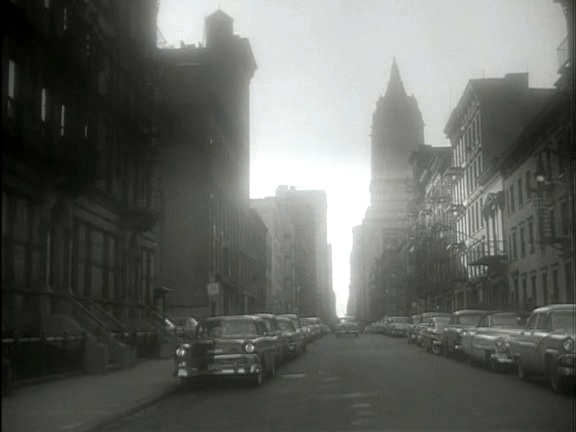
Odds Against Tomorrow (UA 1959) – 96 min.
Director – Robert Wise
Writing credits:
William P. McGivern – novel
Abraham Polonsky (front John O. Killens) and Nelson Gidding – screenplay
Cast:
Harry Belafonte – Johnny Ingram
Robert Ryan – Earle Slater
Shelley Winters – Lorry
Ed Begley – Dave Burke
Gloria Grahame – Helen
Will Kuluva – Bacco
Kim Hamilton – Ruth Ingram
Mae Barnes – Annie
Richard Bright – Coco
Carmen De Lavallade – Kittie
Lew Gallo – Moriarty
Lois Thorne – Edie Ingram
Produced by:
Phil Stein – associate producer
Robert Wise – producer
Harry Belafonte – co-producer (uncredited)
Original Music -John Lewis
Cinematography – Joseph C. Brun
Editor – Dede Allan
Film filmed on location in the town of Hudson in the Hudson River Valley, New York City, and at the Gold Medal Studios in the Bronx.
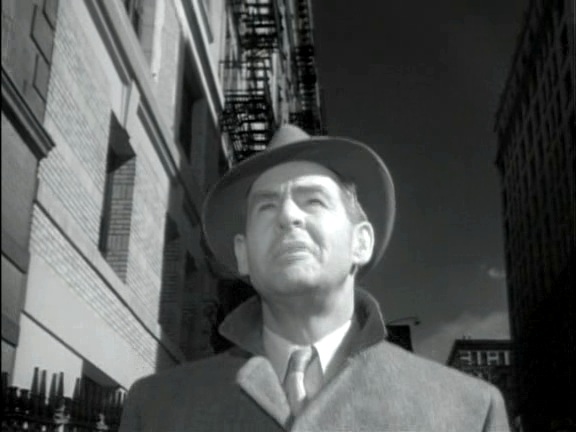
“There is no idea, no theory, no way of life that cannot be reshaped, illuminated and
made more human by being subject to the imagination and criticism of the artist.”
– Abraham Polonsky
UK film writer Philip French in the Observer in 2009 related that Odds Against Tomorrow (1959) “was the favourite film of Jean-Pierre Melville, who saw it 120 times before directing his noir masterwork Le deuxième soufflé [1966]”. I can share this enthusiasm.
Odds Against Tomorrow is a work of art: truly the culmination of film noir and deserving of much greater recognition not only as a consummate film but as the harbinger of the re-invention of noir in the 60s by Sam Fuller in Hollywood and Melville in France. Most commentators see Orson Welle’s Touch of Evil (1958) as the valedictory film noir of the classic cycle, but to my mind that film’s cross-border setting and non-urban locale do not truly reflect the big city alienation that distinguishes the classic noir cycle. In Odds Against Tomorrow, New York City and its industrial fringe are quasi-protagonists that harbor the angst and desperation of life outside the mainstream – sordid dreams of the last big heist that will fix everything. But as always in the noir universe the relentlessly deterministic metropolis in cahoots with capricious fate kick those dreams out of the ring.
A disgraced ex-cop on the cusp of old-age plans a ‘dream’ heist that will see to his retirement, and he needs two desperate men to help do the deed. The ex-cop, Dave Burke, played by Ed Begley, moving from wild optimism to a quiet desperation, does his research well and identifies two guys that are hungry enough to take the bait. Robert Ryan is Earle Slater, a moody violent veteran who after killing a man is just out of stir, and living with a loving woman played by Shelley Winters, who supports them both. But Earle can’t stomach being supported by a woman, he is no longer young, and he is going nowhere. Harry Belafonte plays a young black jazz musician, Johnny Ingram, with a betting addiction, and who is in hock to a local hood and can’t find the dough. Burke particularly needs a black guy as the hijacking and impersonation of a black café delivery waiter is essential to his plan. Earle is unsure about the job, but his frustration and circumstances bring him round. Johnny sees the plan as wobbly, and anyway his creditor, a hood named Bacco, who has a soft spot for him, is taking instalments for the interest. But in a particularly mean act of treachery Burke convinces Bacco to play hard-ball and demand immediate payment, by guaranteeing the debt. Belafonte gets himself in deeper by playing fast and loose with a gun when pressed for payment, and alienates Bacco big time.
The scene where Burke propositions Bacco is nicely crafted by director Robert Wise. Bacco is in central park feeding pigeons on an open expanse of grass against the city skyline as Burke approaches. After some small-talk as Burke also feeds the pigeons, Burke makes a sudden movement towards Bacco which spooks the birds and gets Burke up-close to Bacco so that he can sotto-voce hatch his stratagem.

Both Earle and Johnny are angry men. Earle a racist at every opportunity denigrates Johnny, who is estranged from his middle-class black wife and young daughter. She wants a life for the child and Johnny will only put her aspirations in jeopardy. Although they still love each other, she won’t take him back. Johnny betrays a seething resentment against an excluding white society triggered by a visit to his wife’s apartment when she is hosting a school PTA meeting, which includes white parents:
Ruth Ingram (flaring): I am trying to make a world fit for Edie to live in. It’s a cinch you’re not going to do it with a deck of cards and a racing form.
Johnny Ingram: But you are, huh? You and your big white brothers. Drink enough tea with ’em and stay out of the watermelon patch and maybe our little colored girl will grow up to be Miss America, is that it?
The suppressed rage of these two men and their mutual antagonism have explosive consequences.
The day of the heist dawns and the gang heads up-state to an industrial town on the Hudson river. The robbery goes down but goes horribly wrong. Burke is dead at the scene, and in a chase that culminates in an oil refinery, Earle and Johnny blow themselves to smithereens in a final shoot-out atop a gasoline silo. There is no romanticism and the scene is reminiscent of Raoul Walsh’s White Heat (1949)only in its technical aspects. When the bodies are recovered at the refinery in the final scene, race is a ‘dead’ issue:
Cop to another cop: Well, these are the two that did it.
Morgue attendant: Which is which?
Cop: Take your pick.

Abe Polonsky’s impressive screenplay takes William P. McGivern’ s basic story and adds deeper characterisations, while removing McGivern’s dramatic and poetically redemptive ending. Polonsky’s denoument is harshly final and without sentiment or pity, but he adds more depth to the Dave Burke and Johnny Ingram characters. In the book Dave Burke is thinly drawn and is not in on the actual heist, and Johnny Ingram is not fully drawn until after the heist. Polonsky had to use a front as he was still blacklisted 10 years after the punks at HUAC destroyed his career. Robert Ryan himself was an activist committed to liberal causes such as SANE and the ACLU.
In June 1999 film writer Louis Proyect attended a screening of Odds Against Tomorrow. After the screening Polonksy, Belafonte, and composer Tom Lewis spoke on a panel hosted by John Schultheiss, a critical contributor to Polonsky’s ‘Odds Against Tomorrow: The Critical Edition’ (Cal State, 1999). Proyect reported:
In a montage of ‘race understanding’ films from the mid 1950s, Schultheiss [explained] how unique Odds Against Tomorrow was. In prior films such as The Defiant Ones, there is a plea for racial tolerance but the black character is always sacrificed in the process. Chained to white racist escaped convict Tony Curtis, fellow escapee Sidney Poitier constantly goes out of his way to show the audience that he will turn the other cheek, while Curtis keeps slapping it. Belafonte explained that he wanted to depict a black character who would not stand for any humiliation. It was also a way to tell Hollywood that he would not kowtow to their idea of how a black character should behave. [Note by Tony D’Ambra: Schultheiss apparently did not mention Joseph L. Mankiewicz’s noir No Way Out (Fox 1950), starring Sidney Poitier, which pre-dates The Defiant Ones, and could be seen to have an empowered black protagonist.]
Belafonte had put his own fortune and reputation on the line. Waiving his fee as an actor, and fronting a quarter-million dollars, he sought to break new ground cinematically. In Schultheiss’s commentary on the film, Belafonte is quoted, “My own personal desire was to put things on the screen that reflected the deeper resonance of black life, things that had never been approached before, even within the United Artists realm.” His partnership with United Artists was a reflection of the special role of the company in Hollywood, which was to be obliterated by corporate ownership a decade or so later. Formed by Charlie Chaplin in the 1920s, United Artists was cooperatively owned by actors, screenwriters and directors who wanted to make uncompromising films…
Schultheiss posed a provocative question to Polonsky. How did his belief in progressive politics square with his decision to write a film with criminals as central characters, who had no socially redeeming qualities? Was it difficult to make what was essentially an entertainment about hardboiled criminals, when his stated beliefs revolved around transforming American society? Polonsky, never one to mince words, practically spit [sic] out his reply. He said that American society itself was criminal and that the film’s characters were just trapped within the system…
Belafonte made two decisions that reflected his own uncompromising beliefs. He hired Abraham Polonsky to write the film, who was still blacklisted. Belafonte’s connections to this world was rooted in his own experience as a blacklistee. What enabled him to break free of McCarthyite repression was his unique folksinging talent, which attracted the support of Ed Sullivan who featured Belafonte regularly on his popular Sunday night television variety show. [Writer Paul] Buhle told me that despite this, Sullivan was a run-of-the-mill red-baiter, who had viciously attacked Polonsky in a newspaper column in the same year Odds Against Tomorrow was being filmed.
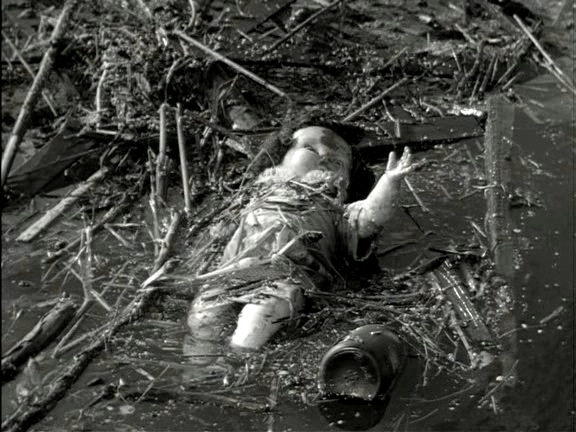
The cast is uniformly strong, with a young Belafonte holding his own with veterans Begley and Ryan. Belafonte in a nuanced portrayal convincingly captures the contradictions of a man the prisoner of a gambling habit who loves his family dearly. Begley is pitch perfect as the desperate yet naïve mastermind. Ryan is brilliant as the moody troubled veteran with a rampant anger and racial hatred, who yet manages a tenderness that attracts and holds a decent woman, then cheats on her in vengeful anger when they fight. Gloria Grahame as a young mother and neighbor, who is memorable in a small role, is perversely attracted to this seething violence. The seduction scene is packed with a fierce eroticism.
What makes Odd Against Tomorrow a work of art? Undoubtedly it is the result of a synergy grown from the craft and commitment of a talented film-making team. I have spoken of the screenplay and the cast, and now I need to address the polished achievements of those that put the movie together. Together with DP Joseph C. Brun, Wise re-casts New York as the noir city, with a deep focus, canny lighting, and killer perspectives. As a cinematic city of a haunting cold beauty, a brooding realm where its denizens tread bright boulevards in a bleached-out bizarre dream dreamt by ‘mad men’. The AFI informs us that in an interview Wise said: “I did something in Odds Against Tomorrow I’d been wanting to do in some pictures but hadn’t had the chance. I wanted a certain kind of mood in some sequences, such as the opening when Robert Ryan is walking down West Side Street…I used infra-red film. You have to be very careful with that because it turns green things white, and you can’t get too close on people’s faces. It does distort them but gives that wonderful quality—black skies with white clouds—and it changes the feeling and look of the scenes.” [Robert Wise On His Films (Silman-James, 1995) p. 157]. Those stark monochrome compositions are wonderfully evident in scene after scene. The framing and lighting is stunning. Indeed, the picture has a sort of late-period neo-realism with a French noir patina. The photography shows a city in the throes of a radical re-invention that is adopting the angular mood evident in the new model cars on its streets – all thrust, sharp angles, and fins. The doomed protagonists stand out as anachronisms in this bold new world, and only Johnny puts on a brave front with a flashy white sports-car and dark glasses.
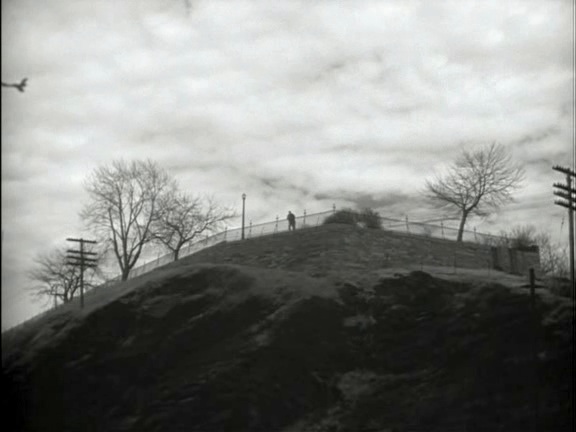
Composer John Lewis’s edgy modern jazz score, played by an ensemble that included Milt Jackson on vibraphone, Percy Heath on bass, Connie Kay on drums, Bill Evans on piano, and Jim Hall on guitar, is demanding and intrusive in a way that gives it an unprecedented role in proceedings. It takes on the role of a Greek chorus that exceeds its mandate by persistently and loudly challenging the protagonists’ actions. Though the soundtrack has quiet piano interludes and significant long silent scenes where nothing much happens – particularly an extended sequence in which each gang-member waits out the afternoon before the heist alone in a desolate industrial landscape on the banks of the Hudson river, its calm beauty sacrificed to the garbage strawn in the water along its shores, and to an overcast desolation. In one scene, Johnny sitting on a dock spies a disturbing object in the water – it turns out to be a ‘white’ doll entangled in kelp and garbage. A commentary by Ted Farlow for a 2008 MoMA screening of the movie nicely conveys the artistry at work: “Bill Evans [on piano], harmonizes beautifully with Dede Allen’s taut editing—with its stretches of haunting silence and its use of shock cuts in place of traditional fades and dissolves—and with Joseph Brun’s stark black-and-white cinematography”.
In the December 31, 1958 issue of Variety, a staff writer deftly encapsulates the movie’s strengths: “Director Robert Wise has drawn fine performances from his players. It is the most sustained acting Belafonte has done. Ryan makes the flesh crawl as the fanatical bigot. Begley turns in a superb study of a foolish, befuddled man who dies, as he has lived, without knowing quite what he has been involved in. Shelley Winters etches a memorable portrait, and Gloria Grahame is poignant in a brief appearance. Joseph Brun’s black and white photography catches the grim spirit of the story and accents it with some glinting mood shots. John Lewis’ music backs it with a neurotic, edgy, progressive jazz score.”
I am edging towards seeing Odds Against Tomorrow as greater than Wise’s other noir masterpiece The Set-Up (1949).
A must-see, Odds Against Tomorrow will screen at the NY Film Forum Wednesday August 17 at 1:00pm, 4:45pm, and 8:30pm. It is available on DVD.
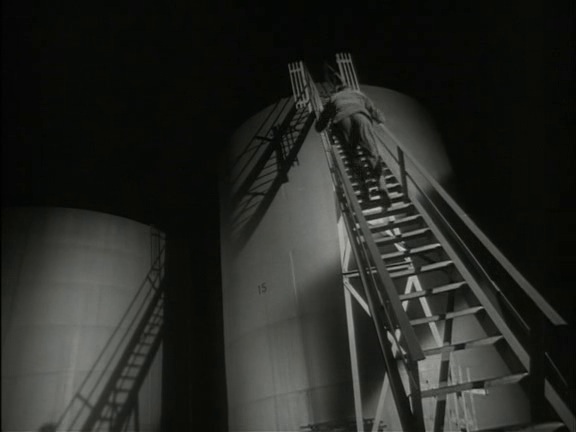

You and Melville are right. Odds is a culmination of noir and Belafonte deserves a ton of credit for his fidelity to the genre. The song “All Men Are Evil” is one of the noir anthems.
LikeLike
Hi Tony,
You highlight a movie here that I’ve managed to somehow miss in all my film noir viewing. I love Melville’s neo-noirs from the 60’s and I’m now super interested in seeing this one considering you and Melville view it so highly. You contrast this with Touch of Evil at the beginning in terms of the “end of the cycle”. Do you view Touch of Evil as more a reflection of the neo-noir era then, if it’s not the capstone to the traditional cycle? Or does it not fit in either eras for you?
LikeLike
This is an absolutely stunning essay. I’d go as far as to say that it contends for the greatest I’ve ever read by any writer, at any site, on any subject. (I’ve been blogging for five years now). The high superlatives are deserved, as you have probed beneath the surface to present a persuasive argument for the film’s standing in the film noir category, but beyond that to examine the components, the characters, the setting and the film’s reputation. Though I can’t say I am wholly surprised that Melville saw the film 120 times (after all he was as impassioned a cineastes as ever lived) but it’s certainly telling that he gravitated towards this film in particular. Your broaching of the Hudson Valley setting is more than significant for me, as I know the location, and much like the shooting of ON THE WATERFRONT in Hoboken, it offers up a challenge at some point to see what still stands. I love the suggestion of the Greek chorus for John Lewis’s jazzy score, and the “fierce eroticism” present in the seduction scene. Certainly, Polonsky’s screenplay is extraordinary, and your generously sprinkled this study with telling quotes and references.
This is truly a “celebration” of ODDS AGAINST TOMORROW (your new position of where it ranks among Wise’s films is most interesting!) and I can’t wait to see it again at the Film Forum on August 17th!
LikeLike
Thanks Samuel, Jon, and Sam. Great to have your comments.
Samuel, I will have to revisit Belafonte’s early recordings, and ‘All Men Are Evil’ in particular.
You have posed a challenging set of questions Jon! As with every Welles film, Touch of Evil, I feel, cannot be contained stylistically, while Odds Against Tomorrow is decidely noir. Noirs for me are concerned with the modern metropolis and the particular alienation that accompanies the anonymity of city life. The protagonists in Touch of Evil are authority figures in their respective small-town communities, and the story is more concerned with the corruption and moral dissolution grown of unbridled authority rather than the desperation of outsiders. In essence, Odds Against Tomorrow is more noir. This response may not satisfy you, but it is about as clearly as I can express a distinction that comes from a feeling and not from any rigorous analysis.
Sam, as ever you are much too kind. I am glad you will be catching the movie in NY next month. I hope you will at least come some way towards my feelings for the film.. It certainly deserves more recognition and mounts as strong an argument as I can muster that Wise deserves greater critical respect.
LikeLike
Tony, thank you for elaborating. Although my personal definition of noir deals more with overall tone and outlook, rather than the setting, I understand your distinction. I am going to then associate your distinction and definintion of noir with another “troubling” noir and assume then that you wouldn’t feel that Night of the Hunter really fits with noir either based on it being in a country, rural setting.
LikeLike
Jon, sorry to complicate matters, but no I don’t see Night of the Hunter as a noir, but for different reasons 🙂 In my review of Night of the Hunter, I describe it as a Gothic melodrama.
LikeLike
A real scholar’s piece. No wonder everyone is issuing so much praise. Like the use of critical excerpts, though this is a film I’ve yet to see. I know I’ll have my chance later in the month, and may be able to do it. I was always one to say that The Set-Up was Wise’s finest, but I may yet change that position.
LikeLike
Thanks Frank! Great to have you visit.
LikeLike
Well, I am back from the Film Forum, where I can strongly second your effusive praise for this film, and can further appreciate your stellar tratment here in nevery sense. Yes, the Central Park scene is fantastic, the characterizations deep, the performances by Ryan, Begley and Belafonts first rate and the location cinematography moody and atmospheric.
I personally think you may have hit the bullseye with that statement about the film being Wise’s finest as a solo director. (I’m not counting WEST SIDE STORY, but that’s a different animal).
The failed back robbery is a stunning sequence throughout, and at the very end when the bodies are indistinguishible, the racial underpinning yields its most profound statement.
The print used by the Film Forum was razor sharp and gorgeous, and the audience was near a sell-out. (The film was screened with Lang’s CLASH BY NIGHT).
LikeLike
Great to hear you share my enthusiasm Sam! I wish I had your opportunity to see it on the big screen.
LikeLike
It’s a joy to see so much commentary on this movie. I’ve been waiting for this for years now.
To the author of the review…
I salute your recognition of Odds as a great picture. For my two cents, it’s truly one of the best. I do, however, question your comments on Touch of Evil. To exclude it from the noir category requires the use of some sort of restrictive set of criteria – a method used by many critics – for analyzing these works. A number of great crime dramas from the classic period did not exclusively use cities as their setting. Using a similar style of analysis, other critics might say that Odds itself should be excluded because it does not employ the typical manipulative woman. [Although Gloria Grahame’s Helen is up to no good (and still hot as blue blazes)] Also, I see the metropolis/fate combination as – yes – factors but not the crucial element that sends the conspirators’ plan up in flames in this one. Consider Polonsky. A writer of his brilliance would not tell a story without including the human element. He shows us how institutional injustice (a factor that you note in his comments at the screening) combined with a basic failure to cooperate calls the shots. Something as immaterial, super-structural, and generally inexplicable as fate just is not in his toolbox. Are the forces that are against this dysfunctional team the protagonists? Burke has been beaten down for trying to do the right thing (not unlike Polonsky himself). Slater has served his country and tried to make it in a peaceful world. Ingram is trying to be a good father, but the economic demands and the social injustice keep knocking him down. As with most all noirs (including Polonsky’s earlier work Force of Evil), even these leading role characters are faulted – and deeply so. As is the case with the best of these flicks, good and evil are like the shades of grey that those cinematographers used so well.
I had no idea that Belafonte had been blacklisted. Seems that since he did Carmen Jones in ’54 and performed on the Academy Awards show in ’56 he was still being allowed to work. However, if Paul Buhle (the ultimate expert) confirmed it then I believe it to be so.
Thanks to all for letting me yap, yap, yap…
LikeLiked by 1 person
Hi Rob. Thanks for your great observations here. I don’t disagree with you and I certainly don’t exclude Touch of Evil from the noir canon, it’s just that I feel Odds Against Tomorrow has a greater claim to ‘noirdom’.
Fatalism to me is perhaps the most common of noir motifs. You are right to declaim Polonsky’s deep humanism. But both in McGivern’s book and in Polonsky’s screenplay it is fate that finally determines the protagonists’ destinies: Johnny being accosted by the cop at the traffic accident, and finally the police patrol car by chance being on the scene. Ultimately each guy takes on fate by his actions. I am reminded of a great line from Dassin’s equally brilliant, Riffifi. The wife of one of the hoods, whose young son is kidnapped by a rival gang, confronts the hood with these words: “There are kids… millions of kids who have grown up poor. Like you. How did it happen… What was the difference between you and them that you became a hood, a tough guy, and not them? Know what I think Jo, they’re the tough guys, not you.”
LikeLike
Think I now know everything possible about this movie except the location of the Bar .
Does anybody out there know ?
LikeLike
Hi John. Cigar Joe may know as he has cased most of the locations in the movie – see these posts:
http://filmsnoir.net/film_noir/hudson-ny-scenes-from-odds-against-tomorrow-then-and-now.html
http://filmsnoir.net/film_noir/cigar-joes-latest-homage-to-film-noir-girl-trap.html
I will refer you query to him.
LikeLike
Hi John,
The bar just may have been a set at Gold Medal Studios, Bronx, New York City. Or it just may have been an actual location, that is one I haven’t tracked down.
cj
LikeLike
Many thanks
Yes makes sense , but I meant the location which is obviously a street, and even the inside of the Bar looks pretty real ?
The other outside location not found yet is the appartment which Robert Ryan lived in ?
The concentration seems to be on Hudson and I kick myself because I visted a place called Deposit and could have made a detour .
Looks like I am not alone in spending a lot of my youth in movie houses.
Not had as much fun since discovering the locations for ” Sweet smell of success ” !
Regards to all you film buffs !
LikeLike
Looks like the street location of the best scene in the Movie was not noted -great shame -maybe Harry knows !
Regards to all
LikeLike
Looks like a very tough one even for Cigar Joe to answer.
The only clues number 395 on Royal hamburger across from bar ,and Empire State Building in background and not to far away ?
Note a few spectators watching Robert Ryan walking up to and entering the bar .
The wonders of the pause button !
LikeLike
Seems to tough even for Cigar joe .
The only clues to the location of the bar is the No 395 on the royal hamburger place opposite the bar ,and Empire State Building in the near distance ?
LikeLike
Thanks for the additional clues John. FYI, the first post from a new commenter is moderated, thus the delay in having your earlier contribution published.
LikeLike
I don’t quite get the significance of Ingram asking Slater for the car key. It was never established earlier that Johnny would be doing the getaway car duties after the heist so why should Earle give him the keys? Can someone enlighten, or is this a slip-up in the script?
Thanks in advance.
LikeLike
Hi Ed. In a later scene Burke is clearly perturbed when Slater hands him the car key. Slater’s racist distrust of Ingram is the dynamic of the final scenario. A copy of the script is here http://www.scribd.com/mobile/doc/53373617.
LikeLike
Come on you New Yorkers,figured out where the Bar was or is located as yet ?
LikeLike
Finally discovered the location 3rd avenue and 28th street.
LikeLike
Thanks John. Great work! Sorry your comment was in moderation for a couple of days. The site went down on that day, and I didn’t get the usual email alerts of new comments.
LikeLike
There is a deep connection between Odds and the strange and equally great underrated gem Kiss me Deadly by Aldrich.Both films are actually apocalyptic in nature.Odds fissionable material is racism and Kiss material is atomic..both end in a mind blowing Armageddon as human greed and folly accelerate the doomed characters to a fiery end.Nearly all the players in both dramas are blinded by their desperation to escape their circumstances by the big score so they can liberate themselves from their respective prisons in post war materialistic america.Both films are masterpieces noir or no noir…
LikeLike
Thanks for the great contribution David. Your observations point to how important the greatness of the screenplay is in both films. Bezzeridis for Kiss Me Deadly and Polonsky for Odds Against Tomorrow: true subversives or in modern parlance disruptives.
LikeLike
I would like to comment on the depiction of violence in Odds .My brother who is both a film and sound editor and has taught at such films schools as Usc ,has shown Odds to his graduate and undergraduate students.Considering the age difference,sometimes a two generation gap between my brother and his students this incident always happens. The violence in Odds is so real, so disturbing that considering what his students have seen in recent movies,when Baco whips Johnny with the pearls and threatens to destroy everything Johnny has,including his family his students always gasp and move uncomfortably in their seats.The scene is so brilliantly lit and constructed and flares up the images of master and slave from a hundred years ago,it near fails to stun his students. Another such impact on the audience is the bar scene with Earl as he teaches the young marine a lesson in the manly arts of destruction.Any man who has experienced and Earl like encounter in his life clutches his stomach as the action unfolds.Just a few of many scenes of existential dread that overflows in this great great film..
LikeLike